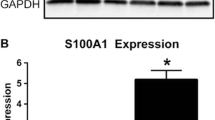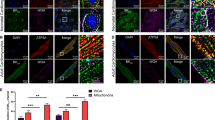Abstract
The TWIK-related K+ channel (TREK-1) is a two-pore-domain potassium channel that produces background leaky potassium currents. TREK-1 has a protective role against ischemia-induced neuronal damage. TREK-1 is also expressed in the heart, but its role in myocardial ischemia-reperfusion (IR)-induced injury has not been examined. In the current study, we used a TREK-1 knockout (KO) mouse model to show that TREK-1 has a critical role in the cardiac I/R-induced injury and during remodeling after myocardial infarction (MI). At baseline, TREK-1 KO mice had similar blood pressure and heart rate as the wild-type (WT) mice. However, the lack of TREK-1 was associated with increased susceptibility to ischemic injury and compromised functional recovery following ex vivo I/R-induced injury. TREK-1 deficiency increased infarct size following permanent coronary artery ligation, resulting in greater systolic dysfunction than the WT counterpart. Electrocardiographic (ECG) analysis revealed QT interval prolongation in TREK-1 KO mice, but normal heart rate (HR). Acutely isolated TREK-1 KO cardiomyocytes exhibited prolonged Ca2+ transient duration associated with action potential duration (APD) prolongation. Our data suggest that TREK-1 has a protective effect against I/R-induced injury and influences the post-MI remodeling processes by regulating membrane potential and maintaining intracellular Ca2+ homeostasis. These data suggest that TREK-1 activation could be an effective strategy to provide cardioprotection against ischemia-induced damage.






Similar content being viewed by others
References
Abraham DM, Lee TE, Watson LJ, Mao L, Chandok G, Wang HG, Frangakis S, Pitt GS, Shah SH, Wolf MJ, Rockman HA (2018) The two-pore domain potassium channel TREK-1 mediates cardiac fibrosis and diastolic dysfunction. J Clin Invest 128:4843–4855. https://doi.org/10.1172/JCI95945
Adolph EF (1948) Tolerance to cold and anoxia in infant rats. Am J Phys 155:366–377. https://doi.org/10.1152/ajplegacy.1948.155.3.366
Aimond F, Rauzier JM, Bony C, Vassort G (2000) Simultaneous activation of p38 MAPK and p42/44 MAPK by ATP stimulates the K+ current ITREK in cardiomyocytes. J Biol Chem 275:39110–39116. https://doi.org/10.1074/jbc.M008192200
Alam MA, Parks C, Mancarella S (2016) Long-term blood pressure measurement in freely moving mice using telemetry. Journal of visualized experiments : JoVE. https://doi.org/10.3791/53991
Bandulik S, Tauber P, Lalli E, Barhanin J, Warth R (2015) Two-pore domain potassium channels in the adrenal cortex. Arch Eur J Physiol 467:1027–1042. https://doi.org/10.1007/s00424-014-1628-6
Bista P, Cerina M, Ehling P, Leist M, Pape HC, Meuth SG, Budde T (2015) The role of two-pore-domain background K(+) (K(2)p) channels in the thalamus. Arch Eur J Physiol 467:895–905. https://doi.org/10.1007/s00424-014-1632-x
Blondeau N, Petrault O, Manta S, Giordanengo V, Gounon P, Bordet R, Lazdunski M, Heurteaux C (2007) Polyunsaturated fatty acids are cerebral vasodilators via the TREK-1 potassium channel. Circ Res 101:176–184. https://doi.org/10.1161/CIRCRESAHA.107.154443
Bodnar M, Schlichthorl G, Daut J (2015) The potassium current carried by TREK-1 channels in rat cardiac ventricular muscle. Arch Eur J Physiol 467:1069–1079. https://doi.org/10.1007/s00424-014-1678-9
Carmeliet E (1999) Cardiac ionic currents and acute ischemia: from channels to arrhythmias. Physiol Rev 79:917–1017
Decher N, Kiper AK, Rolfes C, Schulze-Bahr E, Rinne S (2015) The role of acid-sensitive two-pore domain potassium channels in cardiac electrophysiology: focus on arrhythmias. Arch Eur J Physiol 467:1055–1067. https://doi.org/10.1007/s00424-014-1637-5
Decher N, Wemhoner K, Rinne S, Netter MF, Zuzarte M, Aller MI, Kaufmann SG, Li XT, Meuth SG, Daut J, Sachse FB, Maier SK (2011) Knock-out of the potassium channel TASK-1 leads to a prolonged QT interval and a disturbed QRS complex. Cell Physiol Biochem 28:77–86. https://doi.org/10.1159/000331715
Ehling P, Cerina M, Budde T, Meuth SG, Bittner S (2015) The CNS under pathophysiologic attack--examining the role of K(2)p channels. Arch Eur J Physiol 467:959–972. https://doi.org/10.1007/s00424-014-1664-2
Ferrera R, Larese A, Berthod F, Guidollet J, Rodriguez C, Dureau G, Dittmar A (1993) Quantitative reduction of MTT by hearts biopsies in vitro is an index of viability. J Mol Cell Cardiol 25:1091–1099. https://doi.org/10.1006/jmcc.1993.1121
Gurney A, Manoury B (2009) Two-pore potassium channels in the cardiovascular system. Eur Biophys J 38:305–318. https://doi.org/10.1007/s00249-008-0326-8
Heurteaux C, Guy N, Laigle C, Blondeau N, Duprat F, Mazzuca M, Lang-Lazdunski L, Widmann C, Zanzouri M, Romey G, Lazdunski M (2004) TREK-1, a K+ channel involved in neuroprotection and general anesthesia. EMBO J 23:2684–2695. https://doi.org/10.1038/sj.emboj.7600234
Kang D, Han J, Kim D (2006) Mechanism of inhibition of TREK-2 (K2P10.1) by the Gq-coupled M3 muscarinic receptor. Am J Physiol Cell Physiol 291:C649–C656. https://doi.org/10.1152/ajpcell.00047.2006
Lauritzen I, Blondeau N, Heurteaux C, Widmann C, Romey G, Lazdunski M (2000) Polyunsaturated fatty acids are potent neuroprotectors. EMBO J 19:1784–1793. https://doi.org/10.1093/emboj/19.8.1784
Lehnart SE, Terrenoire C, Reiken S, Wehrens XH, Song LS, Tillman EJ, Mancarella S, Coromilas J, Lederer WJ, Kass RS, Marks AR (2006) Stabilization of cardiac ryanodine receptor prevents intracellular calcium leak and arrhythmias. Proc Natl Acad Sci U S A 103:7906–7910. https://doi.org/10.1073/pnas.0602133103
Li X, Matta SM, Sullivan RD, Bahouth SW (2014) Carvedilol reverses cardiac insufficiency in AKAP5 knockout mice by normalizing the activities of calcineurin and CaMKII. Cardiovasc Res 104:270–279. https://doi.org/10.1093/cvr/cvu209
Ma R, Seifi M, Papanikolaou M, Brown JF, Swinny JD, Lewis A (2018) TREK-1 channel expression in smooth muscle as a target for regulating murine intestinal contractility: therapeutic implications for motility disorders. Front Physiol 9:157. https://doi.org/10.3389/fphys.2018.00157
Mancarella S, Yue Y, Karnabi E, Qu Y, El-Sherif N, Boutjdir M (2008) Impaired Ca2+ homeostasis is associated with atrial fibrillation in the alpha1D L-type Ca2+ channel KO mouse. Am J Phys Heart Circ Phys 295:H2017–H2024. https://doi.org/10.1152/ajpheart.00537.2008
Mathie A (2007) Neuronal two-pore-domain potassium channels and their regulation by G protein-coupled receptors. J Physiol 578:377–385. https://doi.org/10.1113/jphysiol.2006.121582
Mortola JP (1999) How newborn mammals cope with hypoxia. Respir Physiol 116:95–103
Namiranian K, Lloyd EE, Crossland RF, Marrelli SP, Taffet GE, Reddy AK, Hartley CJ, Bryan RM Jr (2010) Cerebrovascular responses in mice deficient in the potassium channel, TREK-1. Am J Phys Regul Integr Comp Phys 299:R461–R469. https://doi.org/10.1152/ajpregu.00057.2010
Parks C, Alam MA, Sullivan R, Mancarella S (2016) STIM1-dependent Ca(2+) microdomains are required for myofilament remodeling and signaling in the heart. Sci Rep 6:25372. https://doi.org/10.1038/srep25372
Patel AJ, Honore E, Maingret F, Lesage F, Fink M, Duprat F, Lazdunski M (1998) A mammalian two pore domain mechano-gated S-like K+ channel. EMBO J 17:4283–4290. https://doi.org/10.1093/emboj/17.15.4283
Schmeling WT, Warltier DC, McDonald DJ, Madsen KE, Atlee JL, Kampine JP (1991) Prolongation of the QT interval by enflurane, isoflurane, and halothane in humans. Anesth Analg 72:137–144
Schwingshackl A, Teng B, Makena P, Ghosh M, Sinclair SE, Luellen C, Balasz L, Rovnaghi C, Bryan RM, Lloyd EE, Fitzpatrick E, Saravia JS, Cormier SA, Waters CM (2014) Deficiency of the two-pore-domain potassium channel TREK-1 promotes hyperoxia-induced lung injury. Crit Care Med 42:e692–e701. https://doi.org/10.1097/CCM.0000000000000603
Terrenoire C, Lauritzen I, Lesage F, Romey G, Lazdunski M (2001) A TREK-1-like potassium channel in atrial cells inhibited by beta-adrenergic stimulation and activated by volatile anesthetics. Circ Res 89:336–342
Tong L, Cai M, Huang Y, Zhang H, Su B, Li Z, Dong H (2014) Activation of K(2)P channel-TREK1 mediates the neuroprotection induced by sevoflurane preconditioning. Br J Anaesth 113:157–167. https://doi.org/10.1093/bja/aet338
Unudurthi SD, Wu X, Qian L, Amari F, Onal B, Li N, Makara MA, Smith SA, Snyder J, Fedorov VV, Coppola V, Anderson ME, Mohler PJ, Hund TJ (2016) Two-pore K+ channel TREK-1 regulates sinoatrial node membrane excitability. J Am Heart Assoc 5:e002865. https://doi.org/10.1161/JAHA.115.002865
Van der Vusse GJ, Reneman RS, van Bilsen M (1997) Accumulation of arachidonic acid in ischemic/reperfused cardiac tissue: possible causes and consequences. Prostaglandins Leukot Essent Fat Acids 57:85–93
Whyte SD, Booker PD, Buckley DG (2005) The effects of propofol and sevoflurane on the QT interval and transmural dispersion of repolarization in children. Anesth Analg 100:71–77. https://doi.org/10.1213/01.ANE.0000140781.18391.41
Xian Tao L, Dyachenko V, Zuzarte M, Putzke C, Preisig-Muller R, Isenberg G, Daut J (2006) The stretch-activated potassium channel TREK-1 in rat cardiac ventricular muscle. Cardiovasc Res 69:86–97. https://doi.org/10.1016/j.cardiores.2005.08.018
Yang X, Guo P, Li J, Wang W, Xu S, Wang L, Wang X (2014) Functional study of TREK-1 potassium channels during rat heart development and cardiac ischemia using RNAi techniques. J Cardiovasc Pharmacol 64:142–150. https://doi.org/10.1097/FJC.0000000000000099
Yeap XY, Dehn S, Adelman J, Lipsitz J, Thorp EB (2013) Quantitation of acute necrosis after experimental myocardial infarction. Methods Mol Biol 1004:115–133. https://doi.org/10.1007/978-1-62703-383-1_9
Yildirim H, Adanir T, Atay A, Katircioglu K, Savaci S (2004) The effects of sevoflurane, isoflurane and desflurane on QT interval of the ECG. Eur J Anaesthesiol 21:566–570
Zhang H, Shepherd N, Creazzo TL (2008) Temperature-sensitive TREK currents contribute to setting the resting membrane potential in embryonic atrial myocytes. J Physiol 586:3645–3656. https://doi.org/10.1113/jphysiol.2008.153395
Acknowledgments
We would like to thank Mr. Jesse Gammons for his comments during the editing of this manuscript.
Funding
This work was supported by intramural department funds and by National Heart, Lung and Blood Institute (grant number HL114869, to Dr. S.M. and HL131526 and HL123540 to CMW).
Author information
Authors and Affiliations
Contributions
SM was the principal investigator of the study and participated in the design of the study, carried out the experiments, performed the statistical analysis, and drafted the manuscript. SK analyzed Ca2+ transients measurements. AS and CW provided the TREK-1 KO mice and edited the manuscript. All authors read and approved the final manuscript.
Corresponding author
Ethics declarations
All animal experiments were performed according to protocols approved by the Institutional Animal Care and Use Committees and comply with USA regulations on animal experimentation.
Conflict of interest
The authors declare that they have no competing interests.
Informed consent
Informed consent was obtained from all individual participants included in the study.
Additional information
Publisher’s note
Springer Nature remains neutral with regard to jurisdictional claims in published maps and institutional affiliations.
Rights and permissions
About this article
Cite this article
Kamatham, S., Waters, C.M., Schwingshackl, A. et al. TREK-1 protects the heart against ischemia-reperfusion-induced injury and from adverse remodeling after myocardial infarction. Pflugers Arch - Eur J Physiol 471, 1263–1272 (2019). https://doi.org/10.1007/s00424-019-02306-y
Received:
Revised:
Accepted:
Published:
Issue Date:
DOI: https://doi.org/10.1007/s00424-019-02306-y




